Navratri is a nine-day celebration in which Goddess Durga is worshipped in 9 distinct incarnations. It is among the most important Hindu holidays, which Hindus throughout India commemorate with tremendous zeal. In a year, there are four Navratris, and yet only two, Chaitra Navratri and Sharad Navratri are widely celebrated. This same holiday is celebrated differently in different areas of the country. Even though they worship the same deity, they have different rites.
In Sanskrit, Navratri signifies “nine nights.” On all these nine nights, devotees fast and give special prayers to Maa Durga’s Nine Forms. Goddess Parvati has taken the form of Goddess Durga. She assumed the form of Devi Durga to defeat Mahishasura. Maa Durga is worshipped in nine distinct forms. Here we have listed the sacred Nine beautiful forms of Maa Durga.
Navratri: Nine beautiful forms of Maa Durga
Goddess Shailputri
Goddess Shailputri is Goddess Durga’s initial incarnation. Parvati’s childhood is represented by Shailaputri. Shail is the daughter of the Mountain King, Himavan, and Queen Menavati, so she’s the definition of a mountain. The Devi has taken on the avatar of Shailputri Parvati after giving up her Sati form. She has had a strong devotion to Lord Shiva since she was a child. Goddess Parvati had taken on the form of a common lady in her quest to be one with Lord Mahadev.
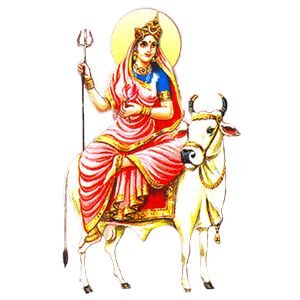
Goddess Brahmacharini
Goddess Brahmacharini is worshipped on the second day of Navratri. Parvati’s austere period is represented by Brahmacharini. Parvati earned this title after years of undergoing austere and difficult penances to marry Lord Mahadev. She is familiar with this form since, as Parvati, she had been meditating to reunite with Shiva as Shakti, guaranteeing that her goal was fulfilled.
Goddess Chandraghanta
Goddess Chandraghanta is worshipped on the 3rd day of Navratri. Parvati is the married form is represented by Chandraghanta. Lord Mahadev bestowed this title on Parvati in response to her desire for Lord Chandradev, the Moon God, to be decorated as an ornament on her forehead, as her Lord was decked upon his crowning of tangled hairs, as he is known throughout the universe as Chandrashekhara. Mahadev changed her wedding appearance into a new shape with a new name after accomplishing her wish. Parvati will be recognized across the globe as Devi Chandraghanta since she now has the finger of the crescent moon on her forehead.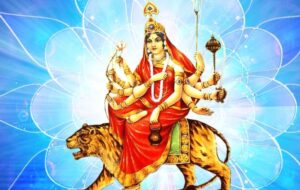
Goddess Kushmanda
Devi Kushmanda is worshhiped on Chaturthi, the fourth day of Navratri. Devi Parvati is represented by Kushmanda as she discovers that she is none other than Mahashakti. Lord Mahadev informed Goddess Parvati of her real existence after their marriage. Lord Mahadev had assisted her in realizing that she is a Goddess, the Mother of the Universe along with all formation, as she gave birth to the 3 dimensions via her golden uterus. This version of her is renowned across the world as Kushmanda, since she possesses a vast array of worldly powers.
Tips to ensure your child stays safe this Diwali
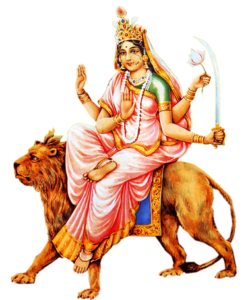
Goddess Skandmata
Panchami is another name for Goddess Skandmata, who is adored on the fifth day. Devi Parvati’s motherhood is represented by Skandamata. Skanda’s son Kartikey is known to be Parvati’s mother. Because as the seed of the energy that Shiva and Parvati generated tumbled to a sleeve of wood, it was divided into 6 newborns, as they were discovered by six women, but after a fair settlement, as Shiva and Parvati decided to merge the six babies into one infant with six faces, he would be known to all as Shanmukha, and Parvati will be recognized as Skandmata, as the mother of this unique child.
Goddess Katyayani
Goddess Katyayani, a manifestation of Shakti, is worshhiped on the sixth day of Navratri. In the warrior form, Katyayani symbolizes Parvati. Whenever the Gods asked Mahashakti to defend them from the demon Mahishasura, Parvati appeared in the form of a ten-armed Goddess, who became known as Katyayani across the globe after she took her birth at the home of sage Katyayan as his daughter and slew the fearsome monster after a lengthy battle. When it comes to protecting herself, she is that avatar of a woman who demonstrates that she is not weak, since she can frequently protect males as well.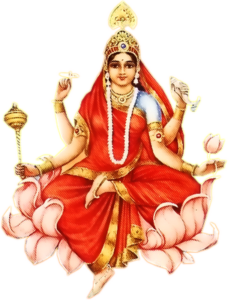
Goddess Kaalratri
Goddess Kaalratri is worshhiped on Saptami, the seventh day of Navratri. Legend has it that she sacrificed her skin tone and adopted black skin to slay devils. Parvati’s destruction phase is represented by Kaalratri. She is known as the Goddess of Time and Death because she is both above and beyond its rule, controlling the moment of somebody’s death and being beyond the darkness. She is also a lady who is continuously angered by wrongdoing and battles to rescue society since she is violent and capable of causing devastation whenever her threshold is exceeded.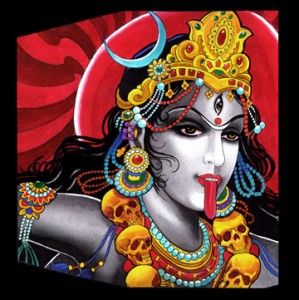
Goddess Mahagauri
Goddess Mahagauri is worshhiped on Durga Ashtami, the eighth day of Navratri. Parvati’s recovery is represented by Mahagauri. Parvati returned to her natural form after embracing her Kali form, albeit with skin as dark as darkness adhering to her form. She submerged herself in the Manasarovar river on Lord Brahma’s command and emerged dazzling as that of the moon, her white clothes and jewels gleaming beautifully. Mahagauri was the appellation given to this form of Parvati throughout the universe. She’s also the embodiment of a woman who is a housewife, loving wife, and nurturing mother, as she is the family’s sole supporter.
Also read, Women safety tips for Navratri
Goddess Siddhidatri
Goddess Siddhidhatri is worshipped on the ninth and last day of Navratri. Siddhidhatri depicts Devi Parvati as she approaches the completion of her greatest and supreme form, understanding who she is like the entire embodiment of Goddess Mahashakti, and so attaining the rank of Goddess. Siddhidatri possesses all mystical powers and, as Ardhanarishwara, is one with Lord Shiva. She is an incarnation of a woman who symbolizes the very giver of power and instils in her children education, teaching skills, and discipline.
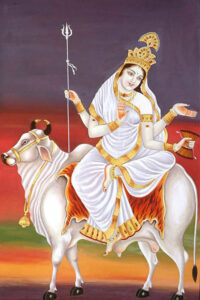
Here are the beautiful Nine beautiful forms of Maa Durga that are worshipped by people across the nation in some or another way. As we move towards different states and cultures we witness different ways of praying maa Durga. Do share your thoughts and ideas on celebrating Navratri and the 9 manifestations of Maa Durga.
I am taking my blog to next level with Blogchatters My Friend Alexa And CauseAChatter”
Copyright Notice- Unauthorized use and/or duplication of this material without express and written permission from this site’s author (owner) is strictly prohibited. Excerpts and links may be used, provided that full and clear credit is given to Rakhi Parsai (Lifethrumyeyes) with appropriate and specific direction to the original content.
If you are a brand and would like to see your products reviewed, please send an email at lifethrumyeyes11@gmail.com or you can also connect with me by clicking on any of these on Facebook | Twitter | Instagram.
****The images taken in the post are from the web. I thank the websites from where I have taken these.





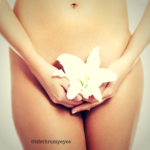

My son was asking me why we have fats for 9 days for Durga when other Gods have only one day ! I made him read this article and he understood .
I had heard only couple of forms out of these. Thank you for sharing all of them.
Thank you for such an informative post
This is really informative. I didn’t know a lot of these stories. Thank you for such a detailed post.
This a such a delightful and informative post. I learned quite a few things today. Thanks for sharing about the different forms of maa Durga. I don’t celebrate Navratri but have always been curious to know more.
This is a detailed post about Navratri. I love these 9 days of festivities and enjoy it with my family and friends.
Good to learn about the different forms in which durga maa is worshipped across the 9 days.. Thanks for summarizing
Thanks for the detailed post and it was quite informative for me. Great to see the various forms of the goddess that are worshipped. Almost depicting the multitasking woman!
Such a perfect post for Navratri occasion Rakhi. Navratri celebration is special occasion at my place since childhood. my mother and father both perfrom devi path 9 days and we used to do Hawan at the last day of Navratri.
Love your discription on the 9 forms of devi ma. Its feels very positive to read on a monday morning
Right post at the right time. I let my son to read this . Thanks Rakhi for this informative mythological post .
This is such a lovely article to read, thank you for sharing about the 9 roops of mata which are worshipped in these days.
Though we celebrate Navratri, I didn’t know so much about all the 9 avatars and reading your blog during navratro has really enlightened me. I’ve learnt something new and interesting today.
All the forms of the Maa Durga are highly regarded and inspiring. Good to revisit all the details in your blog post.
These stories arr very new to me. Thanks for sharing
The charm of the Navratri festival is so divine. The worships of Maa Durga in different parts of India, in different ways, take the ambiance of the festive season on another level. I must say You have shared all the details of 9 days worship of maa in various forms so brilliantly
Nice post..Tamilians customs are slightly different but in essence we all celebrate the power of Durga…